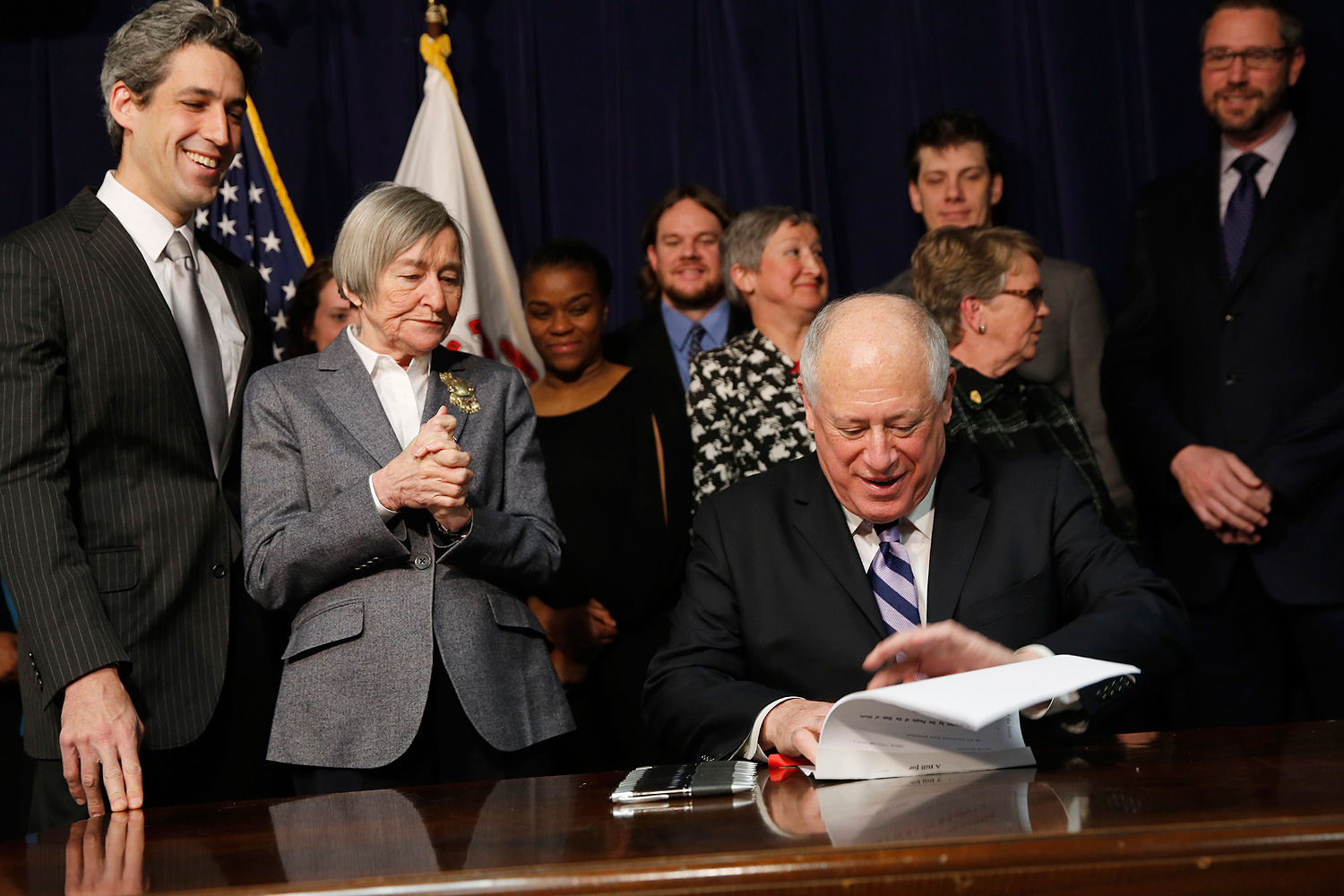I'm embarrassed to say I totally missed this, and had to find out via the New York Times's Josh Barro, because it's right in my wheelhouse:
Starting in 2017, most [Illinois] state residents with jobs who don’t already have a retirement plan at work will be automatically enrolled in individual retirement accounts, funded through a 3 percent deduction from their paychecks.
Daniel Biss—the Illinois state rep senatorand MIT Ph.D.—was the lead sponsor of the legislation, and Governor Quinn just signed it into law this Sunday, making Illinois the first state in the nation to implement an automatic, opt-out retirement-savings plan. And it's an idea with something of a Chicago pedigree, as the publication of Cass Sunstein and Richard Thaler's influential Nudge gave opt-out programs a boost at the political level.
Having an automatic deduction of three percent from your paycheck might initially give you a bit of the big-brother willies at first. It's voluntary, but it's voluntary opt-out, not voluntary opt-in, which has been the standard for most of the history of 401(k) and programs of the like. But the private sector has been moving quickly towards automatic enrollment, from five percent in 2005 to 21 percent in 2010. And people don't opt out:
The investment company Vanguard, which administers 3.4 million workers’ 401(k) plans, found that at companies with voluntary enrollment, only 59 percent of employees participated in 401(k) plans. At companies with automatic enrollment, 86 percent did — and that figure is surely an understatement, since it includes all workers at companies that have automatic enrollment, even though the vast majority offer it only to their new employees.
Furthermore, it moves younger adults into retirement plans at substantial rates: "Fidelity, a Vanguard competitor, says 76 percent of 20- to 24-year-old workers stay in its opt-out plans, compared with 20 percent who sign up for opt-in plans." It doesn't guarantee universal retirement savings, but it gets remarkably close among the working population.
And while it's touted for increasing "participation rates of newly hired employees dramatically, particularly among women, minorities, and low-income earners," there's remarkably little geographic pattern across Chicago and the Chicagoland area. In 2012 the Woodstock Institute looked at the lack of retirement savings among the working population in the state, and it's remarkable for how consistent the percentage of enrolled and unenrolled workers is across the area.
The community area with the highest percentage of workers without access to a retirement plan through their jobs is 56.9 percent in Armour Square. The community areas with the lowest percentages are the Loop and Montclare, with… 53.2 percent. The pattern is exactly the same throughout the six-county region: the percent without access is uniformly in the low- to mid-50s. Ditto for Illinois house districts. A lot of people don't have access, and it's not particular to any place in the state.
By employment there's more variation. Administrative and support jobs, arts/entertainment/recreation, education services, and accommodation and food services—which include a lot of low-paying jobs—bottom out at 73 percent of workers lacking access. And the effect of opt-out seems to be strongest among the working poor:
In a 2001 paper, “The Power of Suggestion: Inertia in 401(k) Participation and Savings Behavior,” Madrian and Shea point to about a 48 percentage point increase in participation among new hires and an 11 percentage point increase overall at a large health services firm 15 months after enrollment. Among women, participation rose from 36 percent to 86 percent; for Hispanics, from 19 percent to 75 percent; and for those earning less than $20,000, from 13 percent to 80 percent.
(Manufacturing employees have the most access in Illinois, at 64 percent, followed by management, finance and insurance, information, and transportation and warehousing at 59 percent. In other words, generally higher-paying jobs.)
One thing to keep an eye on with Illinois's plan is the default savings rate. What inertia gives, it also takes away:
Money tends to stick where it lands. In that study, 65 percent to 87 percent of participants stayed with the company specified default (2 percent to 3 percent) and remain in default funds, typically conservative. That percentage slowly declined, but even after two years, 40 percent to 54 percent still clung to the default. The fear is that auto-enrollment, as useful as it has become, may drag down retirement savings if default contribution rates are too low.
Three percent isn't much, as Biss acknowledged to Barro, and is lower than the average (although a two-year timeframe for voluntarily increasing it isn't much, either), which is why the next frontier is auto-escalation:
A recent study by Principal Financial Group, Des Moines, Iowa, found that when participants were given a choice to opt-in for auto escalation, only 6% did so. T. Rowe Price Retirement Services, Baltimore, reported that 10.5% of participants in client plans offering automatic escalation via opt-in programs chose to participate.
Among those with opt-out auto escalation, 86% of participants stayed with annual increases, Principal said. At T. Rowe Price, 69% continued with the program.
Those who are automatically enrolled will want to keep an eye on it, whether they can afford the three percent, and whether they can afford to increase it. For those who don't, it'll begin to build a small nest egg—and more broadly, an interesting experiment in nudging residents towards retirement.



